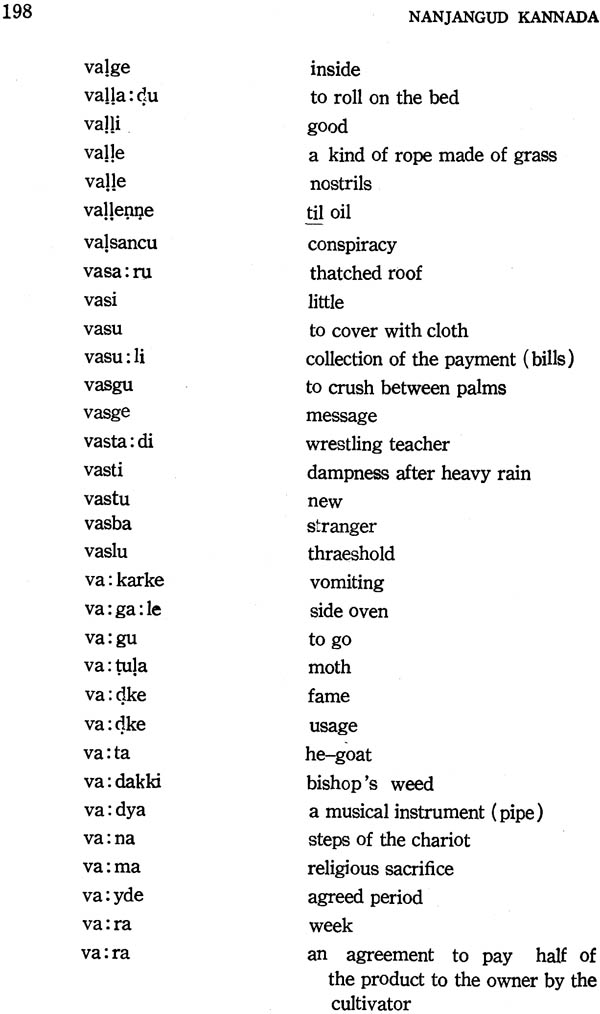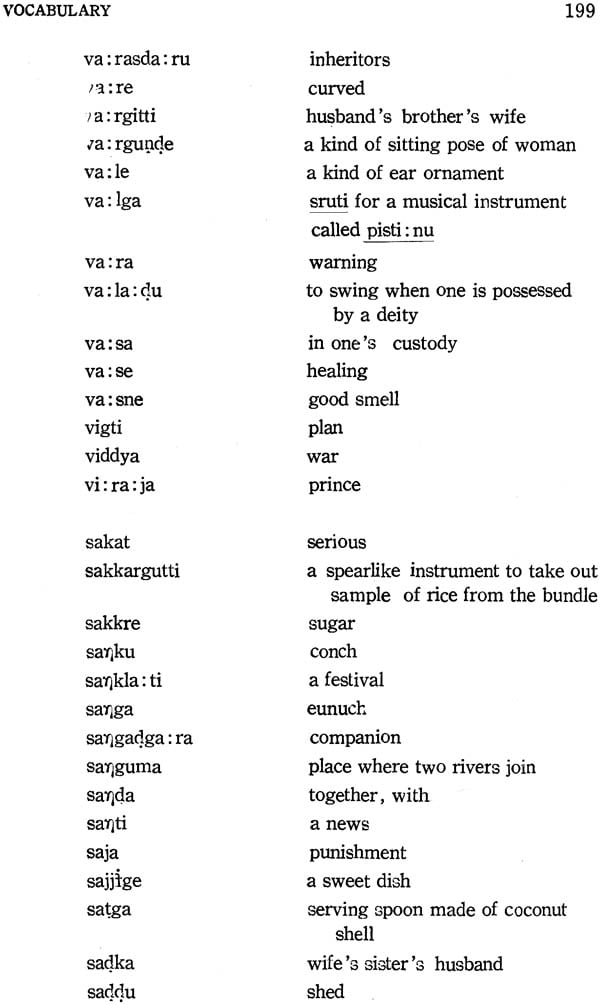
Nanjangud Kannada (Vakkaliga Dialect)
Book Specification
| Item Code: | NAM126 |
| Author: | U. P. Upadhyaya |
| Publisher: | Deccan College Postgraduate and Research Institute |
| Language: | English |
| Edition: | 1968 |
| Pages: | 217 |
| Cover: | Paperback |
| Other Details | 8.5 inch x 5.5 inch |
| Weight | 240 gm |
Book Description
Nanjangud is the central taluk of the southernmost district of the Mysore. It is fourteen miles south of the city of Mysore which had been the capital of the former princely state. The dialect of Kannada spoken in this area is popularly known as Mysore Kannada. The present study is based on the speech of the Vakkaligas who form a major non-Brahmin community of this area, mostly engaged in agriculture. Mr. Nanjappa, the informant, is an elderly man, about years old, who in addition to agriculture had also practiced wrestling He is uneducated and monolingual. The data consists of about four thousand vocabulary items, paradigms of a number of nouns and verbs, hundred sentences and mine stories. These were orally transcribed and recorded on tape during the month of October 1965 at Nanjangud.
The initial h of the standard language was found elided in this dialect. Initially o: has become va: before non-high vowels and o has become va before all vowels. Initial e and e: have also become va and va: respectively before a. In the case of verbal bases, the final e has become i. The assimilation of d and r to the following 1 (as in sadlu>sallu ‘loose’ sidlu>sillu ‘thunder’ karlu>kallu ‘intestine’ karlu>kallu ‘intestine’ narlu>nallu ‘to moan’ etc.)
And the change of r to n before a retroflex stop (as in kurda> kunda ‘blind’ burde>bunde ‘skull’ karta>kanta ‘shell’ etc.) are of special interest. Dropping of the final nasal n has left its trace either in the nasalization of the preceding vowel or in the conversion of the preceding consonant into a homorganic nasal in instances like avan>ava ‘he’ (but aval>ava ‘she’), magan>mana ‘son’ (but magal>maga ‘daughter’).It is possible that the exception to these changes may be due to the borrowing from the standard dialect.
In the third person non-neuter singular forms of the past-tense forms, the distinction between masculine and feminine is lost. The personal suffixes occurring after the past-stem are different from those of the standard dialect to a considerable extent. Future forms of the standard language are not found in the dialect. The subjunctive suffix occurs as i while the potential is represented by the suffix-avu in this dialect. Infinitive form occurring before negative modal-illa has two freely varying shapes with l and n as in nagl-illa-nagn-illa ‘did not laugh’. The root iru ‘to be’ has its special forms avni ‘I am’ avi ‘we are’ avne ‘he is’ etc. The absence The absence of retroflexion in the past-tense forms of the reflexive-kallu is another feature as in ma: dkanda ‘he did himself’-Nouns ending in-a show an animate- inanimate distinction as against the rational-irrational distinction of the standard language as the case allomorphy is concerned. Hence the allomorphs na and ge of the genitive and dative suffixes respectively are added not only to nouns denoting rational beings but also to irrational (animate) nouns like kva: na ‘he-buffalo’ va: ta ‘he-goat’ etc. (as in kva: nana va: tange etc.).
I am grateful to Dr. S. M. Katre, Director of the Deccan College, Dr. H. S. Biligiri, and Dr. D. N. Shankara Bhat for their guidance and encouragement.
| 1 | Phonology | 1-31 |
| 1.1 | Inventory | 1 |
| 1.2 | Contrasts | 2 |
| 1.3 | Description | 6 |
| 1.4 | Clusters | 19 |
| 2 | Morphophonemics | 32-37 |
| 3 | Morphology | 38-85 |
| 3.1 | Verbs | 38 |
| 3.1.1 | Verbal bases | 38 |
| 3.1.2 | Classification of bases | 40 |
| 3.1.3 | Sample paradigms | 40 |
| 3.1.4 | Finite forms | 44 |
| 3.1.4 | Non-finite forms | 54 |
| 3.1.6 | Base iru 'to be' | 57 |
| 3.1.7 | Reflexive base | 59 |
| 3.1.8 | Modals | 61 |
| 3.2 | Nouns | 61 |
| 3.2.1 | Nominal bases | 61 |
| 3.2.1.1 | Simple bases | 62 |
| 3.2.1.2 | Derived bases | 63 |
| 3.2.2 | Plural forms | 71 |
| 3.2.3 | Classification of bases | 73 |
| 3.2.4 | Case forms | 73 |
| 3.2.4.1 | Morphophonemic alternations | 75 |
| 3.2.4.2 | Allomorphy of case suffixes | 77 |
| 3.2.4.3 | Post-positions | 81 |
| 3.2.5 | Sample paradigms | 82 |
| 3.2.6 | Numerals | 84 |
| 4 | Texts | 86-96 |
| (i) | Sanima: ra: yan kate | 86 |
| (ii) | ra: gsan kate | 89 |
| (iii) | ganpati kate | 92 |
| (iv) | gombe enti | 94 |
| 5 | Sentences | 97-105 |
| 6 | Vocabulary | 106-207 |













